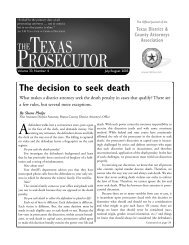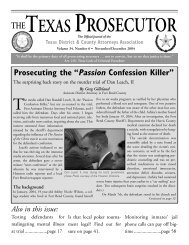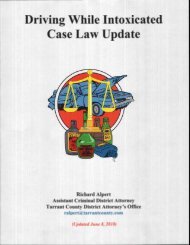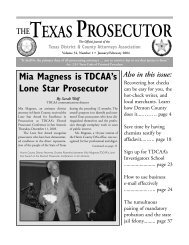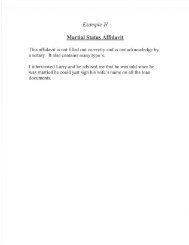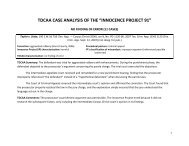Driving While Intoxicated Case Law Update - Texas District ...
Driving While Intoxicated Case Law Update - Texas District ...
Driving While Intoxicated Case Law Update - Texas District ...
Create successful ePaper yourself
Turn your PDF publications into a flip-book with our unique Google optimized e-Paper software.
G. FAILURE TO EXPLAIN FST'S IN DEFENDANT'S NATIVE TONGUE = NO<br />
VIOLATION<br />
Phono Xuan Dao v. State, 337 S.W.3 d 927 (Tex.App.-Houston [14th Dist.] 2011 , pet. ref'd).<br />
No constitutional violation of defendant's rights and no right to a jury instruction when field sobriety<br />
tests are not explained in defendant's native tongue or preferred language.<br />
XVI. SPECIFIC ELEMENTS<br />
A. PUBLIC ROAD. PLACE<br />
1. PARKING LOTS<br />
Rouse v. State, 651 S.W.2d 736 (Tex.Crim.App. [panel op.] 19S3).<br />
State v. Carter, 810 S.W.2d 197 (Tex.Crim.App. 1991).<br />
Thibaut v. State ,782 S.W .2d 307 (Tex.App.-Eastland 1989, no pet.).<br />
Though a "parking lot" is not a "road" under Article 67011-1, evidence may show a road through a<br />
parking lot.<br />
Howard v. State,744S.W.2d 640 (Tex.App.-Houston [14th Dist.] 1987, no pet.).<br />
"lmplied Consent" law does not apply to defendant who was driving on a "parking lot.'<br />
{THIS CASE DOES NOT APPLY TO OFFENSES COMMTTTED AFTER SEPTEMBER 1, 1993<br />
WHEN ARTICLE 6701L-5 51, V.T.C.S WAS AMENDED SUBSTTTUTTNG THE TERM "PUBL|C<br />
PLACE' FOR "pUBLtC HtcHWAy OR BEACH')<br />
Kapuscinski v. State, 878 S.W.2 d 248(Tex.App.-San Antonio 1994, pet. ref'd).<br />
$tate v. Nailor,949 S.W.2d 357 (Tex.App.-San Antonio 1997, no pet.).<br />
Parking lot can be a "public place."<br />
Holloman v. Statg1995 WL 17212433(Tex.App.-Eastland 1995) (Not designated for publication).<br />
The parking lot was a common area for the complex. The manager of the complex testified that<br />
the entire complexwas surrounded by a metalfence, thatthe complex had between 200 and 300<br />
residenfg and that the parking lot was a common area for the complex. When a resident moved<br />
into the complex, the resident received a "gate card" which would "electronically trigger the gate<br />
mechanism" to allow the resident to enter the complex. Ihe guesfs to the complex would push the<br />
residenf's apartment number and then the phone in the resrUent's apartment would ring. If the<br />
resident wanted the guest to be admifted, the resident would then push a number and the gate<br />
would open. The apartment complex placed no restrictions on resrdenfs as to whom they could<br />
allow to come intothe complex. Court held sufficient evidence that parking lot was "public placd'.<br />
63



